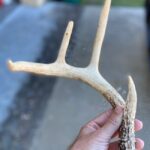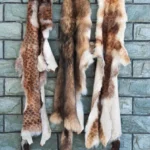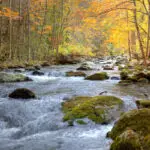Displaying a preserved deer skull can be a great way to commemorate a successful hunt, add some interesting decor to your home, or as a canvas for an awesome art piece.
Whether it’s from your own hunt or finding one in the woods, deer skulls can be taken home, cleaned, and preserved quite easily. Below are some methods for long-term preservation.
Without further ado, let’s take a look at how to clean a deer skull found in the woods!
This page contains affiliate links. As an Amazon Associate, I earn from qualifying purchases.
Table of Contents
Cleaning Deer Skulls
Deer skulls have been preserved for ages so people can keep and enjoy them.
Traditionally, boiling the skull is the quickest and easiest way to clean the flesh off a deer skull. But with additional steps and cleaning products, a cleaner, stronger skull can be achieved that is ready for indoor or outdoor display.
Prep Work
To start, there are some safety precautions you can take to make sure the process goes smoothly for yourself and the skull.
A dead deer’s head can contain bacteria so for this reason, using thick plastic or rubber gloves is recommended when handling the flesh, using a paring knife, or using certain cleaning chemicals.
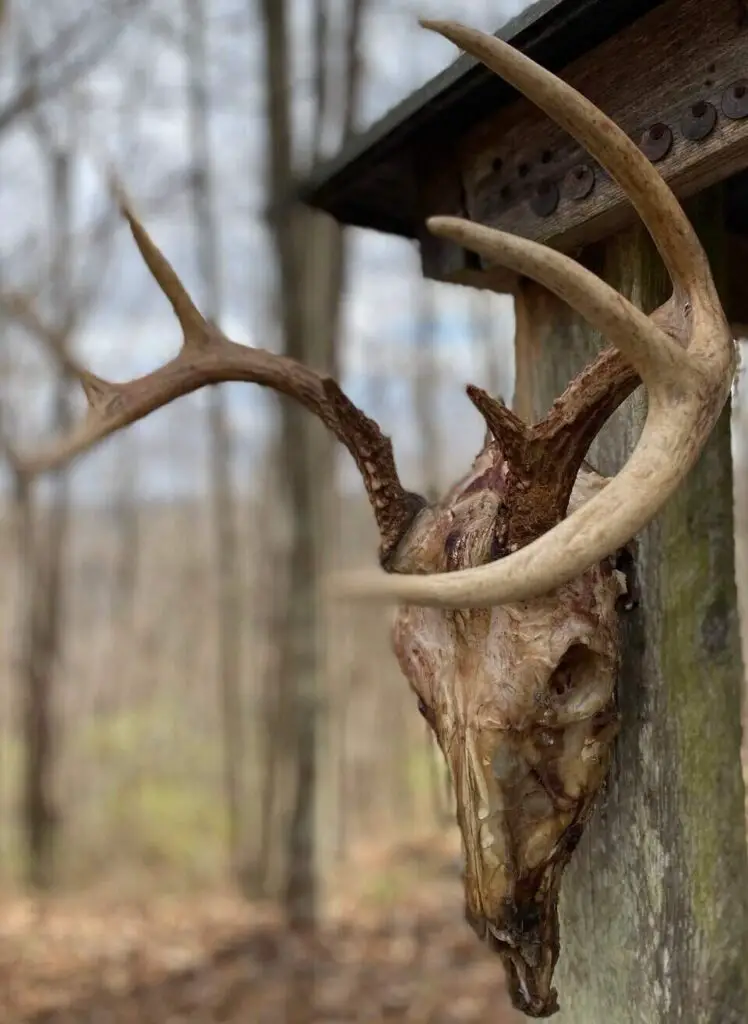
Having good gloves, a sharp paring knife, a way to properly dispose of waste, and clothes you don’t mind getting dirty are all good things to have on hand for this process. Also, be sure to wash your hands frequently when handling the deer skull and flesh.
Having a flat working space, and a hose nearby helps too.
Fur and Flesh
No matter which method you use for removing all the flesh from the deer skull, you must always start by removing the fur, skin, and flesh. This will help make the next steps cleaner and easier.
Do not boil a deer skull with the fur and hide still attached-it will make it very difficult to remove and take much longer.
With a sharp paring knife, run the blade slowly under the fur and skin along all edges of the skull, loosening the connective tissue and peeling as you go. The goal is to leave only the red muscle tissue underneath the hide.
There really isn’t a specific technique; you just want to skin off all the hide and hair so your left with just a raw skull.
You’ll also want to remove the eyes and tongue at this point. The best way to do this is to use pliers, using a pulling and twisting motion to remove the organs (it’s a little gross, I know, but remember you are honoring and saving this relic from a wild creature to enjoy).
Boiling
This quickest and simplest method for loosening and removing the rest of the flesh and brain is to boil the skull. Lower the entirety of the skull into a large pot of boiling water.
You’ll need a large turkey pot and propane burner, and this should only be done outdoors in a safe space.
Fill the pot about 4 inches from the top, and bring it to a slow rolling boil. Place the deer skull into the boiling water and leave the antler out (above the water line…if not, they may discolor and turn white).
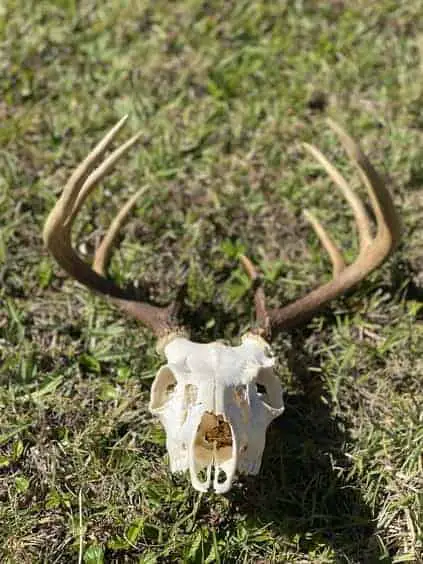
Keep the skull simmering on low for 1 hour. Simmering the skull like this loosens most or all of the flesh and the brain from the bone, making it easier to remove.
At this point you can remove the skull and continue cleaning. Wait until the skull is cool enough to handle but still warm. Pull of any muscle tissue, ligaments and other pieces off with your hands and a small paring knife or spoon.
The more the skull cools down, the harder it will be to clean the flesh. But at this length of time, it should all come off easily.
Continue using your paring knife to carve away at the remaining bits of tissue, while a long wire close hanger can be used to remove the brain from inside of the skull. Remove as much as you can while being careful not to chip the skull bone.
If there are still parts that are too hard to remove, place the skull back in the boiling water for another 20-30 mins and repeat the process until all the flesh is easily removed. Once done, fully rinse off in cold water and let dry overnight.
This method is simple and can be done within a day. However, overboiling deer skulls has been found to weaken the bones and chip the teeth. Over time, the deer skull can become brittle and crack. DO NOT OVERBOIL!
Using Chemicals
While boiling is almost always necessary, there are alternative measures you can take that are not as hard on the skull and will result in a more long-lasting item.
Once the skull has been boiled for 2 to 3 hours, as much as the flesh and brain as possible has been removed and the skull has been rinsed, you can soak the skull in a solution of water, and either basic white vleach powder or hydrogen peroxide to whiten it for display.
Basic white bleach powder is a common hair product used to remove bleach hair, and is commonly found in beauty saloons and drug stores stores.
This product is a safer alternative than pure bleach and is easily mixed with water to form a paste similar to mayonnaise. Slather it all over your boiled deer skull and let dry for 48 hours.
Basic white bleach powder does less damage to the deer skull, as pure bleach is a harsh chemical that weakens the bones and actually doesn’t break down oils as efficiently as the powder.
Another chemical product that can slowly break down the flesh, while leaving the skull undamaged, is hydrogen peroxide. Look for 12% strength liquid hydrogen peroxide in a local pharmacy or order online.
Using the same pre-soak steps as the enzyme bleach powder, properly boil and clean off as much of the flesh as you can.
For this solution, use equal parts hydrogen peroxide and water until the whole skull is covered.
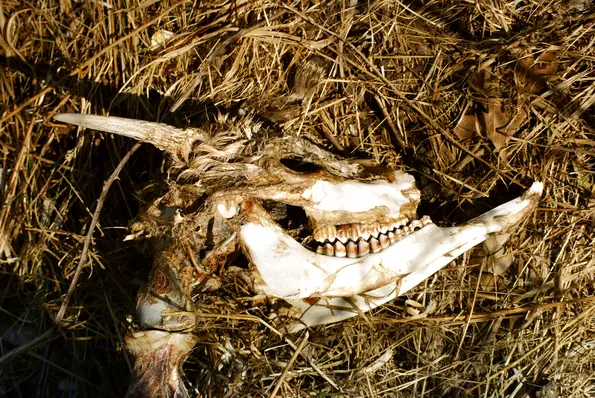
When coming into contact with hydrogen peroxide, always wear appropriate safety gloves and be careful not to get any in your eyes.
Soak the skull for 24 hours. This will fully destroy the remaining tissue, kill any bacteria and clean any dirt that might be left in the skull. Once rinsed and dried, a fully cleaned deer skull is ready to use how you see fit!
Let Nature Clean the Skull
If you’ve got the time, there are two more methods that are sure to do a thorough cleaning job and you’ll barely have to get your hands dirty.
If you’ve ever come into contact with a deer or animal skull in the woods, little bugs and critters consumed every bit of flesh available.
The first of these two methods is buying dermestid beetles and letting them clean off the skull for you. Using this method is popular with taxidermists, so you’ll be able to buy a supply from them or online.
After boiling and doing a once-over of the muscle tissue and brain, put the skull in a plastic container along with a colony of dermestid beetles. Make sure to add air holes so the beetles can breathe but not escape.
Depending on how much you’ve cleaned the skull beforehand and how many beetles you have, they can fully consume every morsel of tissue in just a couple of days. Once they’re done, you can simply release them into the wild.
Penn State University has great information on the protocol that is commonly used with these beetles.
And lastly, for the least work but the most time, you can bury the skull in your backyard and let nature’s critters and organisms do the work!
Burying is recommended because simply leaving it outside can attract undesirable vermin that may even take off with your skull.
The best part of this method is you don’t have to skin or clean the deer head at all. The head will decompose over time and nature will not let anything go to waste.
Over a period of months, the tissue will be slowly eaten away until a completely clean deer skull is left.
People who have tried this technique have seen a clean deer skull in about 10 months to a year. After hosing off the dirt and polishing it up, the deer skull is ready for any decoration or art project.
NOTE: If you leave a deer skull buried out in the woods, it’s going to get a tan/brown patina; some people like this but other people prefer the bleach-white method.
Summary
There are many methods of cleaning off a deer skull to fit your schedule, skills, or the amount of work you want to put in.
Whether fast, easy or thorough, the result is a unique and beautiful skull that honors the deer and can be enjoyed for many years.
Enjoy!

